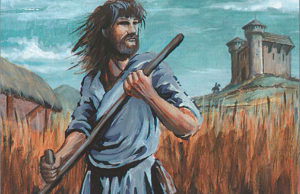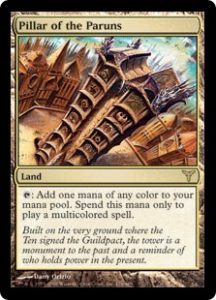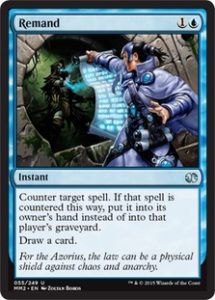The urban plane of Ravnica provides the backdrop to the Uncharted Realms story of this week, and the subject of the next two weeks’ Planeswalker’s Guide to Earth. Having just experienced a Return to Ravnica, I suspect it’ll be a little while before a full set goes back to the City of Guilds, and I want to take the opportunity to explore the plane’s roots in medieval European history. In a landscape otherwise dominated culturally and politically by knightly nobles, religious authority, and the developing monarchy, medieval cities stand out as a setting and social order unlike any other.1
A World Without Cities
The fundamental social units of European order and economy in the fifth to the tenth centuries CE were the farm, the village, and the noble desmense (territory or holding). So much effort was involved in production of a subsistence-level food supply that perhaps as much as ninety percent of the total population was involved directly in agricultural output. The difficulty of food production demanded a society spread across fertile countrysides in which nearly everyone was involved in the production and ostensible protection of agricultural output.
This is not to say that no towns and large villages could survive. Population centers had existed before the year 1000 CE. Rome, the Eternal City, did not vanish overnight when sacked by Visigoths in 410 CE.2 Noble estates and ecclesiastical centers continued to serve as administrative and cultural nexuses. But these were few and far between, fundamentally part of a social and physical landscape totally focused upon food production across a wide rural landscape and dedicated to its military protection and spiritual guidance respectively. Hardly anywhere in Europe could a sustainable population exist completely detached from agricultural activity.
The difficulty of food production demanded a society in which nearly everyone was involved in agricultural output.
But from the tenth century onwards (the traditional end of the so-called “Dark Ages”) things began to change. A variety of trends – including a lasting period of peace, a growing population, and a move towards central monarchy – informed a period of internal growth and development in Europe. Trade began to offer the possibility for profit and revenue without dependence upon sustainable food production. With this opportunity, urban areas evolved, tailored towards a growing global market rather than the needs of base subsistence.3 Medieval Venice, for example, founded on low swampland on the tip of the Adriatic, fed itself through trade and travelers’ fares rather than vast agricultural estates made impossible by its environment.
The Guildpact and Charter
We don’t know about the early history of Ravnica. The city’s origins are shrouded in mystery, dating back to the four-color nephilim and before the rise of the guilds. But the organizations and social order that shape Ravnica hearken back to the coordination of society in medieval cities.
While the circumstances of internal peace and external trade from the tenth century onwards allowed for the development of cities, they still were not the norm. Throughout much of medieval Europe, the traditional social model of agricultural activity prevailed. Nobles fought, clergy prayed, and peasants worked to keep people fed. All of those rules did not apply in the developing medieval city, however, replaced by a social order unique to the urban setting. For once, the peasantry who elsewhere paid rents to feudal lords (for the privilege of working the land to keep literally everyone alive) had common interest, shared goals, and most importantly the cash and accordant power to demand and purchase their freedom from the direct authority of barons and bishops.
What emerged in many major cities was a new social contract and order similar to the Guildpact in both intent and near-mythical importance. Just as the Guildpact (and its magical arbiter Jace) ensures law in Ravnica, the charter granted to medieval cities recognized their unique status confirmed the rights and responsibilities of their residents. City charters, first issued around the turn of the 12th century in Flanders, confirmed the special legal rights of urban populations, freeing them from tolls, noble impositions, and military levies, usually at the cost of a one-time or recurring payment to a local lord.
Peasants held that merely making it within the walls of a city made one free, a magic as powerful as planeswalking.
If the Guildpact created the guilds and thereby the society of Ravnica, medieval charters held the power to create a city apart from the ruling social order of European feudal society. The difference between the city and its surrounding region could be enormous. Outside, a peasant could be legally detained for traveling without permission from their lord, or pressed into service in wartime. They had certain rights, but these were balanced against a very static and conservative social order. The city’s walls and charter granted freedom and unique privilege, otherwise almost unheard of in the medieval period. Without reading or understanding cities’ charters or rules, many still attached to them an almost religious reverence. In the Holy Roman Empire which became modern Germany, peasants held that merely making it within the walls of a city made one free, a magic as powerful as planeswalking for people who perceived the social hierarchy of medieval feudalism as the only world they knew.
But Flanders’ charter and Ravnica’s Guildpact merely formed the legal framework of a city. The city’s life and order, with the rules of feudal society removed, would come to rely upon a unique source of authority and communal organization. Just like the Guildpact, the city charters of medieval metropolises gave rise to guilds, which helped to run some of the flourishing centers of trade, culture and commerce in the medieval world. Join me next week, when we discuss the history of guilds and trade leagues in medieval Europe and the power of the guilds on Ravnica!
Curtis Wiemann likes cities but reads about a lot of them getting sacked.
1Forgive me for ignoring Jace and Ral for a bit.
2In fact it lived to be sacked twice more in the following century (and several times in the medieval period). Rome wasn’t built in a day, and its empire didn’t fall in one either!
3Much of this thesis is drawn from the classic work Medieval Cities: Their Origins and the Revival of Trade, by Henry Pirenne, which is not apparently available online.




